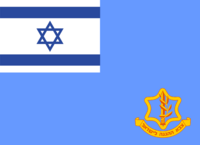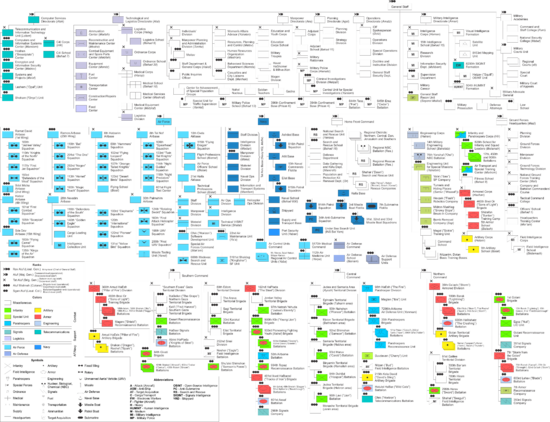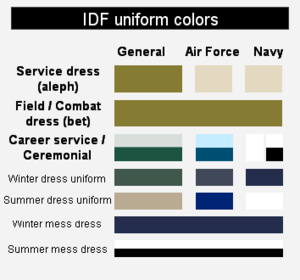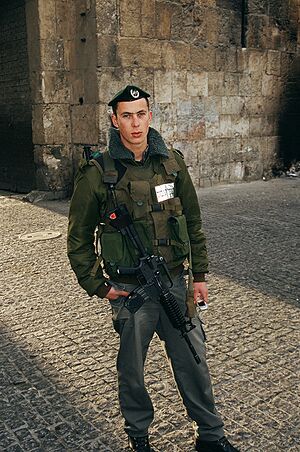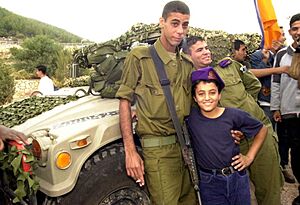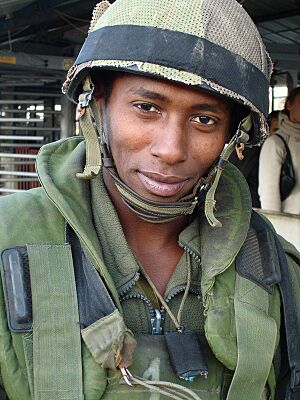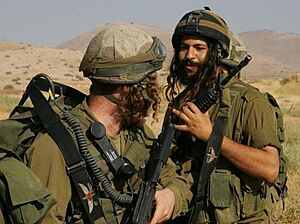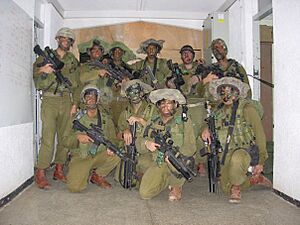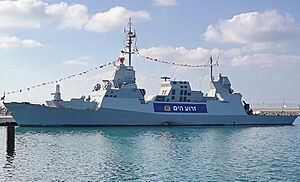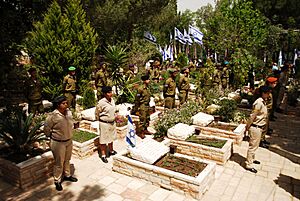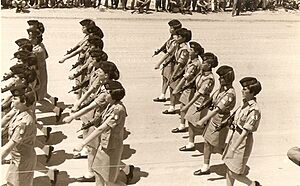Israel Defense Forces facts for kids
Quick facts for kids Israel Defense Forcesצבא ההגנה לישראל |
|
|---|---|
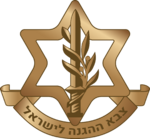 Emblem |
|
| Established | 26 May 1948 |
| Parts |
|
| Leadership | |
| Defense Minister | |
| Serving soldiers | |
| Military age | 17 |
| Conscription | 24–34 months |
| Available to be a soldier |
1,554,186 males, age 17–49 (2016), 1,514,063 females, age 17–49 (2016) |
| Fit to be a soldier |
1,499,998 males, age 17–49 (2016), 1,392,319 females, age 17–49 (2016) |
| Reaching military age annually |
60,000 males (2016), 60,000 females (2016) |
| Active employees/soldiers | 169,500 |
| Reserve personnel | 465,000 |
| Expenditures | |
| Budget | US$24.3 billion (2021) (ranked 15th) |
| Percent of GDP | 5.2% (2021) |
| Industry | |
| Suppliers from inland |
|
| Suppliers from foreign countries |
* |
| See also | |
| History | 1948 Arab–Israeli War (1948–1949) Reprisal operations (1951–1956) Sinai War (1956) Six-Day War (1967) War of Attrition (1967–1970) Yom Kippur War (1973) Operation Litani (1978) 1982 Lebanon War (1982–1985) South Lebanon conflict (1985–2000) First Intifada (1987–1993) Second Intifada (2000–2005) 2006 Lebanon War (2006) Gaza War (2008–2009) (2008–2009) 2012 Gaza War (2012) 2014 Gaza War (2014) 2021 Israel–Palestine crisis (2021) Israel–Hamas war (2023–present) Others |
| Ranks | Israel Defense Forces ranks |
|
|
|
The Israel Defense Forces (IDF), also known as Tzahal (צה״ל) in Hebrew, is the official military of the State of Israel. It was created on May 26, 1948, shortly after Israel became an independent country. The IDF is made up of three main parts: the Israeli Ground Forces, the Israeli Air Force, and the Israeli Navy.
The main job of the IDF is to protect Israel and its people. It is led by the Chief of the General Staff, who works under the Defense Minister. The IDF started with soldiers from groups that existed before Israel became a country. Since then, it has been involved in all major conflicts involving Israel.
Over the years, the IDF has changed its focus. After peace treaties with Egypt and Jordan, it focused more on areas like southern Lebanon and the Palestinian territories. The IDF also works closely with the United States on developing new defense technologies.
Contents
What's in a Name?
The name "Israel Defense Forces" was chosen on May 26, 1948. It means "the army for the defense of Israel" in Hebrew. This name was picked to show that the army's main purpose is to defend the country. It also included the name of an older defense group called Haganah, which the new army was based on.
A Brief History of the IDF
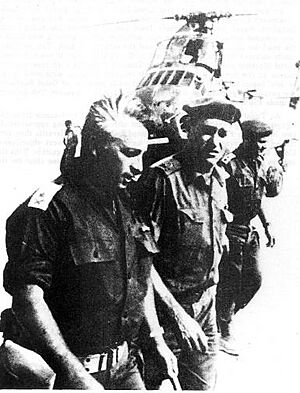
The IDF's roots go back to Jewish defense groups that formed in the early 1900s. These groups, like Hashomer and later the Haganah, helped protect Jewish communities. During World War I, some Jewish soldiers also joined the British Army, gaining military experience.
After Israel declared independence in 1948, Prime Minister David Ben-Gurion ordered the creation of the IDF. All other Jewish armed groups were asked to join the new army. This helped create one strong defense force for the new country.
The IDF quickly faced its first big challenge in the 1948 Arab–Israeli War. After this war, the IDF continued to face smaller conflicts. In 1956, during the Suez Crisis, the IDF captured the Sinai Peninsula from Egypt, which was later returned.
In the Six-Day War of 1967, Israel gained control of the Sinai Peninsula, Gaza Strip, West Bank, and Golan Heights. This changed the balance of power in the region. Later, the Yom Kippur War in 1973 led the IDF to change its training and how it prepared for battles.
Over time, the IDF's role shifted to focus more on fighting smaller conflicts, like urban warfare and stopping terrorism. A famous example was the 1976 Operation Entebbe, where Israeli commandos rescued hijacked airline passengers in Uganda. The IDF also took part in conflicts in Lebanon, pushing out armed groups.
Today, the IDF continues to focus on dealing with various threats, including conflicts with groups in Gaza and along the Syrian border.
How the IDF is Organized

All parts of the IDF report to one main General Staff. The Chief of the General Staff is the highest-ranking officer. This person reports directly to the Defense Minister.
Main Parts of the IDF
The IDF is divided into several main parts:
- Regional Commands: These commands are in charge of different areas of Israel, like the North, Center, South, and the Home Front.
- Ground Arm: This includes soldiers who fight on land, like the Infantry, Armored Corps (tanks), Artillery (big guns), and Combat Engineering (building and clearing obstacles).
- Air and Space Arm: This is the Israeli Air Force, which includes planes, helicopters, and air defense systems.
- Sea Arm: This is the Israeli Navy, which protects Israel's waters.
There are also many administrative branches that help run the army, like the Intelligence Directorate, Manpower Directorate, and Logistics.
Army Unit Sizes
The army is organized into different sized groups:
- Hulya (Fire Team): A small group of soldiers.
- Kita (Squad / Section): A slightly larger group.
- Mahlaka (Platoon): Several squads together.
- Pluga (Company): Several platoons.
- Gdud (Battalion): Several companies.
- Hativa (Brigade): Several battalions.
- Ugda (Division): Several brigades.
- Gayis (Army): The largest grouping.
Ranks, Uniforms, and Badges
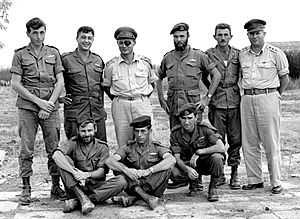
Unlike many other armies, the IDF uses the same rank names for all its branches: army, air force, and navy.
Ranks
Soldiers earn different ranks based on their time in service and training.
- Conscripts (soldiers doing mandatory service):
* Private (Turai) * Corporal (Rav Turai) * Sergeant (Samal) * First Sergeant (Samal Rishon)
- Warrant Officers (experienced non-commissioned officers):
* Sergeant First Class (Rav Samal) * Master Sergeant (Rav Samal Rishon) * Sergeant Major (Rav Samal Mitkadem) * Warrant Officer (Rav Samal Bakhir) * Master Warrant Officer (Rav Nagad Mishneh) * Chief Warrant Officer (Rav Nagad)
- Officers (leaders):
* Second Lieutenant (Segen Mishneh) * Lieutenant (Segen) * Captain (Seren) * Major (Rav Seren) * Lieutenant Colonel (Sgan Aluf) * Colonel (Aluf Mishneh) * Brigadier General (Tat Aluf) * Major General (Aluf) * Lieutenant General (Rav Aluf)
Uniforms
The IDF has different uniforms for different purposes:
- Service dress (Madei Alef): This is the everyday uniform.
- Field dress (Madei Bet): This is worn for combat, training, and work on base.
- Officers / Ceremonial dress (madei srad): Worn by officers or for special events.
Most ground forces wear olive green uniforms. Navy and air force personnel wear beige/tan uniforms. Soldiers also wear different colored berets, which show which unit or corps they belong to. For example, paratroopers wear maroon berets, and Golani Brigade soldiers wear brown.
Insignia

Besides rank badges, IDF soldiers have other badges that show their corps, specific unit, and job.
- A pin on the beret shows the soldier's corps.
- A shoulder tag on the left shoulder strap identifies the specific unit.
- An aiguillette (a braided cord) on the shoulder and a pin can show a soldier's job or special training.
Military Service in Israel
Military service in Israel is generally mandatory for most citizens over 18. There are three main types of service:
- Regular Service: This is the mandatory service required by law. Men usually serve for 32 months (2 years and 8 months), and women serve for two years. Some combat roles for women require three years of service.
- Permanent Service: This is for soldiers who choose to continue serving in the army after their mandatory service, often making it their career. They sign a contract with the IDF.
- Reserve Service: After completing regular service, many citizens are part of the reserve forces. They can be called up for training for about a month every few years, or for active duty during a war. This helps keep the army strong and ready.
Other Ways to Serve
Some young Israelis can choose to serve in other organizations instead of the IDF:
- Israel Border Police: These units work alongside the IDF and are responsible for security in cities and rural areas.
- National Service (Sherut Leumi): This is a non-military option where young people volunteer in areas like education, healthcare, or social work.
Women in the IDF
Israel is one of the few countries where women are required to serve in the military. Most roles in the IDF are open to women. Women serve in many different positions, including combat support and some combat roles. For example, the Caracal Battalion is a mixed-gender unit where men and women serve together in light infantry.
In 2011, Maj. General Orna Barbivai became the first female major general in the IDF, which was a big step for women in the military. The IDF aims for equality, with many jobs open to women.
Minorities in the IDF
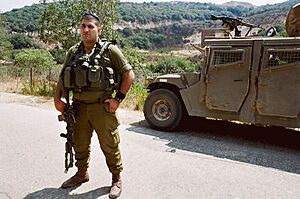
While most IDF soldiers are Jewish, men from the Druze and Circassian communities are also required to serve. Many Druze soldiers have joined regular combat units and reached high ranks. The first Druze aircraft navigator completed his training in 2005.
Bedouin citizens are encouraged to volunteer for service, and many do. Some Israeli Arabs (both Christian and Muslim) also choose to volunteer, even though it's not mandatory for them. There have been several notable Arab officers in the IDF.
The IDF has also worked to help Ethiopian Jews (Beta Israel) integrate into the army and Israeli society. Ethiopian soldiers are often seen as excellent soldiers.
For men in the Haredi (ultra-Orthodox) community, there are special arrangements. They can choose to serve in units like the Netzah Yehuda Battalion, which follows strict Jewish dietary laws and has an environment that fits their religious beliefs.
Deaf and Vegan Soldiers
Israel is unique because it requires deaf and hard-of-hearing people to serve in the military. They are provided with sign language interpreters and usually work in non-combat roles.
Vegan soldiers in the IDF also receive special accommodations. They are given artificial leather boots, a black fleece beret, and vegan food options on all bases.
Volunteers from Other Countries
Young Jewish people from other countries, or Israeli citizens who grew up abroad, can volunteer to serve in the IDF through programs like Mahal. These programs allow them to serve for a shorter period, often including Hebrew language training. Other programs, like Sar-El, offer short-term volunteer work on army bases, doing non-combat tasks.
The IDF's Main Goal
The main goal of the IDF is to "defend the existence, land, and independence of the state of Israel." It also aims to protect the people of Israel and fight against any form of terrorism that threatens daily life.
The IDF believes it must always be ready to act quickly to protect the country. It has adapted its strategies to deal with different types of threats, including terrorist groups.
IDF Code of Conduct
In 1992, the IDF created a Code of Conduct called the "IDF Spirit" (Ru'ah Tzahal). This code combines international laws, Israeli laws, Jewish heritage, and the IDF's traditional values. It guides all soldiers and includes core values like "defense of the state," "love of the homeland," and "human dignity."
What the IDF Spends
Israel spends a part of its money on defense to keep the country safe. This amount has changed over the years, but it's always a significant part of the national budget.
Food for Soldiers
Field rations, called manot krav, are the meals soldiers eat in the field. They often include canned foods like tuna, sardines, beans, and fruit cocktail. They also come with drink powders and condiments like ketchup and jam. Recently, the IDF has introduced freeze-dried meals that can be heated with water.
Weapons and Equipment
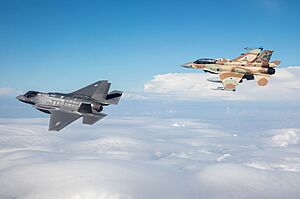
The IDF uses a mix of weapons and equipment from other countries and those made in Israel. For example, they use M4A1 and M16 rifles from the US, as well as F-15 and F-16 fighter jets.
Israel also has its own strong weapons industry. It develops and produces its own equipment, like the Merkava battle tank, the Galil and Tavor assault rifles, and the Uzi submachine gun.
Key Israeli Defense Technologies
Israel is known for its advanced military technology, especially in:
- Firearms: Like the Uzi submachine gun and Tavor assault rifle.
- Armored Vehicles: Such as the Merkava tanks and armored bulldozers.
- Drones: Israel is a leading exporter of unmanned aerial vehicles (UAVs).
- Missile Systems:
* The Arrow system helps defend against ballistic missiles. * The Iron Dome system is designed to intercept short-range rockets. * David's Sling protects against medium-range rockets. * Iron Beam is a laser system for very short-range threats.
Israel can also launch its own reconnaissance satellites into space. Many of these technologies have been tested in real-life situations, making them very effective.
-
M2HQCB 0.5
-
Hermes 900 UAV
-
Arrow anti-ballistic missile
-
"Saraph" AH-64D Apache Longbow
-
Iron Dome anti-rocket system launcher
-
Merkava Mk 4m with Trophy active protection system, the first operationally tested Active Protection System for tanks
-
M2 Browning on Catlanit RCWS
Remembering Fallen Soldiers
Yom Hazikaron is Israel's day to remember fallen soldiers. It is observed the day before Israel's Independence Day. This is a time when the country honors those who gave their lives for its defense.
Israel has several military museums, like the Yad La-Shiryon (tank museum) and the Israel Defense Forces History Museum. The National Military Cemetery is located at Mount Herzl.
In the past, the IDF held parades on Independence Day. Now, they have stationary weapon exhibitions across the country instead.
See Also
- Intelligence Community
- Israeli police
- Defense industry of Israel
- Krav Maga (Israeli self-defense system)
- Sherut Leumi (National Service)


